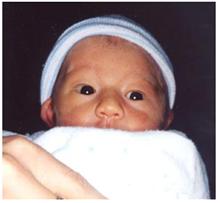신생아 딸꾹질, Hiccup In newborn infants

▴ 사진 2-329. 신생아가 딸꾹질을 하면 춥지 않게 폭신 싸서 안아준다. Copyright ⓒ 2011 John Sangwon Lee, MD, FAAP
-
추울 때, 모유나 인공영양을 급히 먹을 때, 목욕을 시킨 후 바로, 또는 때로는 아무 이유 없이 신생아들이나 영아들이 딸꾹질을 할 수 있다.
-
딸꾹질을 하는 신생아나 영아를 따뜻하게 포근히 안아 주든지, 따뜻한 잠자리에 재우면 딸꾹질이 그치는 것이 보통이다. 때로는 모유나 인공영양을 더 먹이면 딸꾹질이 그칠 수 있다(p.00 딸꾹질 참조).
-
여러 가지 원인으로 횡격막이 간대성 수축을 하면서 소리를 내는 증상 징후를 딸꾹질이라고 한다.
-
신생아들이나 영유아들은 딸꾹질을 아무 병이 없이 자주 할 수 있다.
-
신생아들이나 영유아들의 딸꾹질의 거의가 아무 병도 없이 잠시 동안 지속되다가 자연적으로 그치는 것이 보통이다.
다음과 같은 병이 있을 때 딸꾹질을 할 수 있다.
① 뇌종양, 뇌 손상, 뇌염 등의 뇌 질환
② 횡격막 신경 이상이나 횡격막 주위에 생기는 종양이나 림프절 비대, 늑막염, 폐렴, 심막염 또는 식도염 등으로 횡격막 신경이나 횡격막이 자극 받을 때
③ 외이도 내 이물이나 곤충 등으로 미주신경이 자극될 때
④ 영유아의 무호흡증이나 과도호흡 등으로 인해 딸꾹질이 심하게 장기간 계속될 수 있다.
⑤ 특히 신생아들이나 영유아들의 횡격막 신경이나 미주신경, 또는 횡격막 등이 정상적으로 미숙해서 그들이 찬 인공영양을 먹은 바로 후, 목욕을 한 바로 후, 추울 때, 모유나 인공영양을 급히 먹을 때, 또는 특별한 이유 없이 딸꾹질을 잠시 동안 발작적으로 자주 할 수 있다.
⑥ 삼킨 공기로 인해 횡격막이나 위장관 등이 조금 자극될 때, 또는 주위 온도가 조금 변할 때도 미숙한 미주 신경 등이 자극되어 딸꾹질을 할 수 있다.
이와 같이 신생아들이나 영유아들이 하는 거의 모든 딸꾹질은 하품을 하는 것과 같이 정상 생리현상이다.
신생아들이나 영유아들이 딸꾹질을 자주 한다고 걱정할 필요가 없다.
딸꾹질을 할 때 따뜻한 담요나 포대기 등으로 포근히 싸서 안아주든지 포근히 안고 모유나 따뜻한 인공영양을 먹이든지 따뜻한 잠자리에 재우면 딸꾹질은 자연히 그친다.
여러 가지 민간요법으로 딸꾹질을 치료하기도 하지만 특별한 치료 방법은 아직 없다.
신생아들이나 영유아들의 딸꾹질의 대부분은 자연적으로 그치는 것이 보통이기 때문에 약으로 치료할 필요 없다.
Hiccup In newborn infants 신생아 딸꾹질
▴ Photo 2-329. When a newborn baby hiccups, wrap it up so that it doesn’t get cold and hug it. Copyright ⓒ 2011 John Sangwon Lee, MD, FAAP
• Newborns or infants can hiccup when it is cold, when urgently eating breast milk or artificial nutrition, immediately after bathing, or sometimes for no reason.
• Hiccups usually stop when a newborn or infant who is hiccups is held warmly or when he sleeps in a warm bed. Sometimes, feeding more breast milk or artificial nutrition can stop hiccups (see p.00 Hiccups).
• Hiccups are a symptom of the diaphragm making a sound when the diaphragm contracts due to a number of reasons.
• Newborns and infants can often hiccups without any disease.
• Most of the hiccups in newborns and infants usually last for a while without any disease and then stop spontaneously. Hiccups can occur when your child have the following diseases:
① Brain diseases such as brain tumors, brain damage, and encephalitis
② When the diaphragm nerve or diaphragm is irritated due to diaphragmatic nerve abnormalities, tumors around the diaphragm, enlarged lymph nodes, pleurisy, pneumonia, pericarditis or esophagitis
③ When the vagus nerve is stimulated by foreign objects or insects in the external ear canal
④ Hiccups may continue for a long period of time due to apnea or excessive breathing in infants and young children.
⑤ In particular, the diaphragmatic nerve, vagus nerve, or diaphragm of newborns or infants is normally immature, so immediately after they eat cold artificial nutrition, immediately after bathing, when it is cold, when urgently eating breast milk or artificial nutrition, or for no specific reason. Hiccups can be frequent and seizure for a while.
⑥ When the diaphragm or gastrointestinal tract is slightly irritated by the swallowed air, or when the ambient temperature changes slightly, the immature vagus nerve can be stimulated and hiccups can occur.
Almost all hiccups that newborns and infants do like this are normal physiological phenomena, such as yawning. You don’t have to worry about frequent hiccups in newborns or infants.
Hiccups naturally stop if you hug them with a warm blanket or a wrapper, or if you hug them and feed them with breast milk or warm artificial nutrition, or sleep in a warm bed.
There are several home remedies to treat hiccups, but there is no specific treatment yet. Most of the hiccups in newborns and infants usually stop spontaneously, so there is no need to treat them with medication.
출처 및 참조 문헌 Sources and references
- NelsonTextbook of Pediatrics 22ND Ed
- The Harriet Lane Handbook 22ND Ed
- Growth and development of the children
- Red Book 32nd Ed 2021-2024
- Neonatal Resuscitation, American Academy of Pediatrics
- www.drleepediatrics.com 제3권. 소아청소년 성장 발육 육아
- The Johns Hopkins Hospital, The Harriet Lane Handbook, 18th edition
Copyright ⓒ 2015 John Sangwon Lee, MD., FAAP
“부모도 반의사가 되어야 한다”-내용은 여러분들의 의사로부터 얻은 정보와 진료를 대신할 수 없습니다.
“The information contained in this publication should not be used as a substitute for the medical care and advice of your doctor. There may be variations in treatment that your doctor may recommend based on individual facts and circumstances. “Parental education is the best medicine.”